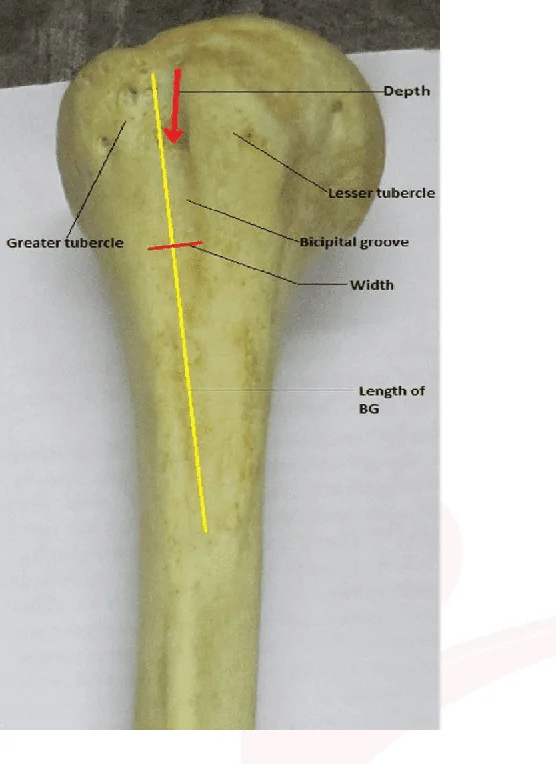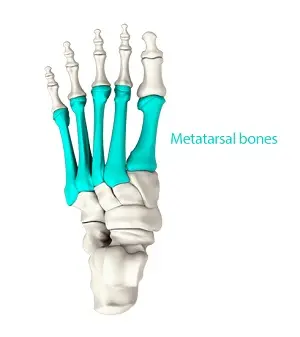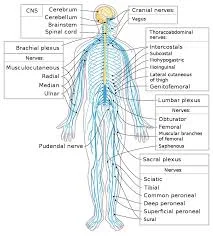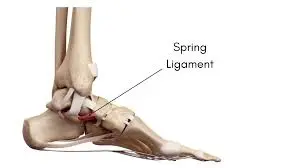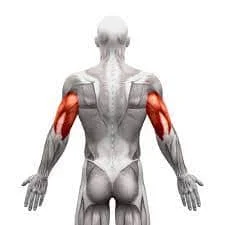Bicipital Groove
Bicipital Groove Anatomy
The Bicipital Groove, also known as the intertubercular groove or sulcus, is an anatomical structure present in the humerus bone of the upper arm. Situated on the front (front) aspect of the bone, the bicipital groove performs a key function in accommodating and protecting the long head of the biceps brachii muscular tendon as it passes from the shoulder to the elbow.
This specific groove helps to preserve the stability and appropriate functioning of the biceps tendon, allowing for smooth movement of the arm and effective transfer of muscle forces. Understanding the structure and significance of the bicipital groove is fundamental in the study of human anatomy, particularly for comprehending the mechanics of the upper limb and the interactions between bones, muscles, and tendons.
It is most convenient to evaluate the bicipital groove along the humerus from behind the patient. Palpate inferiorly from the acromion to identify the bigger tuberosity on one side. Hold one hand at this level while using the other to rotate the arm at the shoulder externally.
Palpating the groove lightly is done since applying too much pressure would hurt. If the long head of the biceps is affected by bicipital tendonitis, even gentle palpation may cause pain.
The bicipital groove separates the larger and smaller tubercles. 4-6 mm in depth, 1 cm in width, and 8 cm in length are typical measurements for people. The teres major tendons on the medial lip and the pectoralis major tendons on the lateral lip are where the long Biceps brachii tendon is lodged. Also, the anterior humeral circumflex artery branches off at the shoulder joint. Insertion of the teres major muscle occurs on the medial lip of this groove.
It curves downward and terminates close to the point where the top layer of the bone joins the middle third. It is the axilla’s lateral wall.
Attachments of Bicipital Groove
Musculotendinous
The following three tendons are inserted in the bicipital groove:
- Pectoralis major, lateral lip;
- latissimus dorsi, floor
- teres major on the medial lip
Relations and Boundaries:
The bicipital groove is located on the anterior surface of the proximal humerus and has the following boundaries:
- Transverse humeral ligament superiorly
- Laterally: the humerus’s increased tuberosity
- Medially: the humerus has reduced tuberosity.
Function
The transverse humeral ligament and the muscular fibers that extend from it stabilize and facilitate the tendon of the long head of the biceps brachi muscle in this groove, preventing subluxation during multidirectional biomechanical movements of the arms. Furthermore, the main biomechanical motions of the biceps brachi muscle, whose tendon is situated in the bicipital groove, are supination, flexion, and screwing.
Clinical Significance
- Biceps tendon dislocation in the long head
- Tear in the pectoralis major
- Injured latissimus dorsi
FAQs
A bicipital groove injection: what is it?
Corticosteroids are injected into the tendon during a bicipital tendon injection to reduce inflammation and pain. Steroids are useful medications that reduce inflammation. It works well to relieve symptoms that last longer than four weeks.
In an MRI, what is the bicipital groove?
Usually, the bicipital groove is between 4 and 6 mm deep 1. It has the tendon of the long head of the biceps brachii muscle, which is covered in the glenohumeral joint’s synovial reflection.
What is the bicipital groove landmark?
Due to its presence in preoperative imaging as well as in the operating field, the bicipital groove has the potential to serve as a reference landmark for precise humeral version reproduction in shoulder arthroplasty.
How are bicipital grooves located?
Palpate inferiorly from the acromion to identify the bigger tuberosity on one side.
What role does the bicipital groove have in medicine?
Bicipital groove pathology may be the source of anterior shoulder pain. Several studies evaluating different methods of treating the long-head biceps tendon (LHBT) have not revealed any clinically significant changes.
Why is the name of the bicipital groove given?
The bicipital groove, a deep groove on the humerus also referred to as the intertubercular groove or sulcus intertubercular, separates the greater and lesser tubercles. It allows the long tendon of the biceps brachii muscle to pass through. To the left is Humerus.
Which anatomical structure occupies the bicipital groove?
The bicipital groove (BG), a hollow created between the greater and lesser humeral tubercles, is home to the ascending branch of the circumflex humeral artery and the long head of the biceps brachii tendon (LHBBT).
In which direction does the bicipital groove nerve pass?
The lateral bicipital groove, which is evident on the lateral aspect of the upper arm, is formed by the same anatomical elements that generate the medial groove. The structures that comprise the medial bicipital grove include the brachial artery, brachial vein, ulnar nerve, and median nerve.
To which muscles does the bicipital groove attach?
Three muscle tendons are inserted in the bicipital groove area:
Pectoralis major: the lateral lip, located on the crest of the greater tuberosity.
Latissimus Dorsi: the ground
The medial lip, or the top of the lesser tuberosity, is Teres major.
Bicipital groove: what is it?
The bicipital groove (BG) is a depression on the anterior aspect of the proximal section of the humerus. The tendon of the long head of the biceps brachi muscle, which is covered in a synovial sheath, and the ascending branch of the anterior circumflex humeral artery.
How is the bicipital groove located?
Put your ring finger on the other tubercle and your index finger on the first tubercle. To palpate the bicipital groove, insert the middle finger of the same hand between the other two fingers. This groove contains the tendon of the long head of the biceps brachii.
Bicipital grooves: where are they found?
the nearest humerus
The tendon of the long head of the biceps brachii muscle is located in the bicipital groove, an indentation that runs along the anterior portion of the proximal humerus.
The bicipital groove contains which ligaments?
The lengthy head of the biceps tendon really fuses with the shoulder joint’s lining as it passes well inside the joint.
References
- Physiotherapist, N. P. (2024, January 14). Bicipital Groove – Anatomy, Attachments, Function. Mobile Physiotherapy Clinic. https://mobilephysiotherapyclinic.in/bicipital-groove/
- Bicipital groove (examination). (2018, January 1). https://gpnotebook.com/pages/musculoskeletal-medicine/bicipital-tendinitis/bicipital-groove-examination

